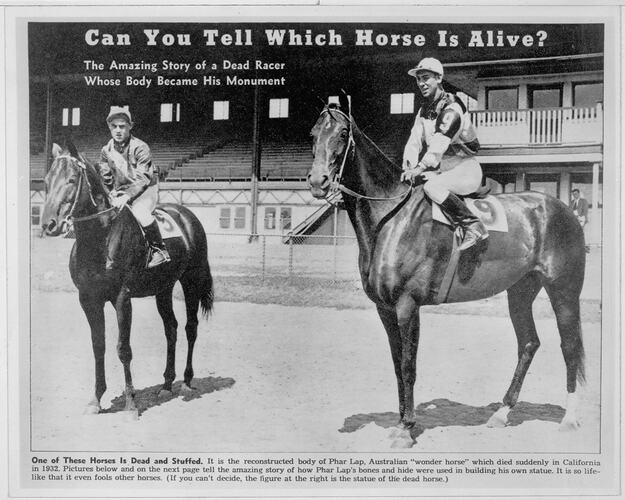Only a few days after the death of Phar Lap in 1932, his owner Mr. David Davis announced that he would have his 'handsome chestnut hide' mounted by a taxidermist. As Phar Lap had died in the United States he turned to the Jonas brothers of Yonkers; Louis, John, and Leslie Jonas, who had been doing remarkable work in preparing wild animals for exhibit, using new methods that increased the life likeness of the subjects. Davis heard of their work and turned the reproduction of Phar Lap over to them.
Louis Jonas attended the Empire City Track in Yonkers to observe horses during their workouts and studied their anatomy in great detail. He spent months researching photographs and footage of Phar Lap in action and a further four months on the actual mounting process.
First they reassembled Phar Lap's skeleton with wire and steel rods. Thin plaster was then applied to both the inside and outside of the skeleton. This was allowed to harden and then sculptor's clay was spread over it.
Louis Jonas then modeled the clay until every tendon and muscle was reproduced exactly as it had appeared in real life. Next, over the clay, the three brothers spread an inch-and-a half-thick layer of plaster of Paris. Strong steel supports were used and clay inserted between sections to permit easy removal when the mould was dry. When the plaster was thoroughly dry, it was removed in sections, some weighing 270 pounds, to form the negative mold in which the permanent base would be built up.
The inside of each section of the mold was carefully coated with wax and strips of roofing paper, which had been soaked in paste, were pressed along the entire inside. Three other layers of paper followed, then two layers of burlap, soaked in a special composition plaster, and finally, an additional three layers of paper.
For a week, the paper and burlap remained in the mold to dry. At the end of that time, it was easily removed, forming a hard shell of unusual strength which reproduced every minute ridge and depression of the original clay model. In the meantime, the clay model had been taken down and the skeleton prepared for shipment to the Dominion Museum in Wellington (now Te Papa) New Zealand. his heart had already been sent to the Australian Institute of Anatomy Collection (later transferred to National Museum of Australia). Ironically, the skeleton was considered the most important specimen at the time and Melbourne Museum had originally accepted the owners offer of the skeleton also, however it was not to be.
The sections of the hardened paper and burlap were then joined together by means of nails hammered into wooden supports that form part of the wood-and-steel framework which braces the interior of the shell. Coatings of shellac were painted on the exterior, sawdust was sprayed on, and other coats of shellac applied. The main base was complete. Only the fine touches remained to be put on.
One of these fine touches was reproducing the veins, especially in the legs. To do this, pieces of rope were immersed in paste and then glued to the form in the exact positions where the veins of the original animal had been. Close-up photographs of Phar Lap's legs as well as anatomical charts, assisted in this phase of the work.
The final step, applying the hide, represented a ground breaking new process in taxidermy. The Jonas brothers developed a flexible plaster, contained nine secret ingredients which was applied to the entire mount, under the skin. This plaster retained its flexibility and elasticity for some time, allowing the taxidermist to sculpture over the hide after it has been attached. By skilful pressure of the fingers and by pushing and pulling the hair this way and that, he can produce lifelike lines and ripples, this is a technique still used in the museum today. The new plaster also acted as pest barrier protecting the mount from attacks by insects and other parasites.
The new techniques employed in the preparation of Phar Laps hide changed the face of taxidermy from that time. It also thrilled the loyal masses around the world, still mourning their beloved racing star, Phar Lap. Tommy Woodcock, Phar Lap's trainer was so over come by the site of Phar Lap's mounted hide when it returned to Australia he was moved to tears. Audiences still marvel at the beauty of Phar Lap in the Melbourne Story Gallery at Melbourne Museum, perhaps not realising the intense artistry and the skill of the taxidermists who prepared his hide.
References
Popular Science Monthly: 1932 Dec. 'Dead Horse "Lives" in Marvel of Taxidermy'
PHAR LAP. (1932, November 23). Newcastle Morning Herald and Miners' Advocate (NSW : 1876 - 1954) , p. 8. Retrieved June 23, 2015, from http://nla.gov.au/nla.news-article135484755
PHAR LAP. (1932, October 21). The Argus (Melbourne, Vic. : 1848 - 1957), p. 5. Retrieved June 23, 2015, from http://nla.gov.au/nla.news-article4504571
PHAR LAP. (1932, April 8). The Maitland Daily Mercury (NSW : 1894 - 1939), p. 7. Retrieved June 23, 2015, from http://nla.gov.au/nla.news-article126692458
PHAR LAP STILL FAVOURITE. (1937, August 2). Newcastle Morning Herald and Miners' Advocate (NSW : 1876 - 1954) , p. 6. Retrieved June 23, 2015, from http://nla.gov.au/nla.news-article134951396
PHAR LAP RESURRECTED. (1932, November 16). The World's News (Sydney, NSW : 1901 - 1955), p. 6. Retrieved June 23, 2015, from http://nla.gov.au/nla.news-article131480802
More Information
-
Keywords
-
Authors
-
Article types

